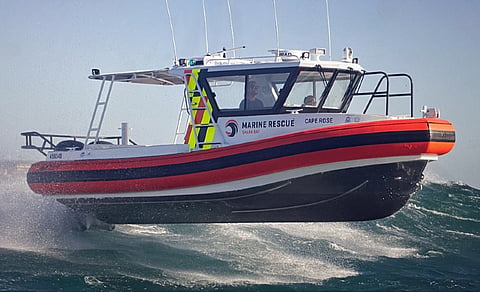

Australian boat builder Dongara Marine recently handed over a new rigid inflatable boat (RIB) to Marine Rescue Shark Bay, an emergency services organisation whose area of responsibility encompasses the waters off the Gascoyne region of Western Australia.
Cape Rose replaces an older boat that had provided search and rescue (SAR) assistance along the WA coastline for more than 20 years after having previously served with the WA Water Police.
Designed by Southerly Designs and acquired at a cost of AU$400,000 (US$294,100), the new boat has a length of 8.3 metres, a beam of 2.95 metres, and a draught of 0.53 metres.
The boat is built with an aluminium hull with a D-section collar. The collar consists of polyethylene foam that has been laser-cut to suit the gunnel shape, with a polymar outer and PVC rubbing strip.
The RIB was custom-built to suit NSCV requirements as well as the specific requirements of the WA Department of Fire and Emergency Services (DFES), which had also funded its construction as part of a wider state government investment in local marine rescue groups.
Based on a proven parent hull form used in large numbers by military and rescue organisations in South East Asia, Cape Rose boasts a design that features increased hull vee and a deeper, extended forefoot to provide enhanced seakeeping as required for operations in the Indian Ocean off the WA coast. Zipwake KB-450 interceptors are fitted to provide dynamic trim control. The craft is road-transportable and capable of being launched directly from the beach into the water, significantly reducing response times.
Dongara Managing Director Rohan Warr said that, being deeper and finer forward, the boat is less prone to bottom and chine slamming than would otherwise be the case. He also noted that the resultant longer deceleration also contributes to a smoother ride.
The builder has further claimed that Cape Rose is a high-volume boat and is thus noticeably larger than is typically associated with a RIB of eight metres' length. The boat features an enclosed cabin with seating for three crewmembers including Shockwave suspension seats for the coxswain and navigator's positions. The cabin sides extend well aft of these positions to provide shelter from the elements but also feature sliding Windows West windows to enable seated personnel to easily converse with people on other boats. Fold-down ladders are fitted on each side to provide ease of access to and from the water.
The cabin is open at the rear, enabling direct access to the work deck, which is sheltered by a solid canopy. A heavy-duty tow post is incorporated into the structure aft, where a bench seat is also fitted.
Accessed through a centreline passage through the wheelhouse console, the forward cabin is primarily arranged for storage but also includes a refrigerator.
The boat is powered by twin Yamaha F200 outboards, which also feature "fly-by-wire" digital electronic control (DEC) throttles, digital instrumentation, and hydraulic steering. On trials, their combined output of 298 kW gave Cape Rose a top speed of 38 knots. However, a service speed of 25 knots will be part of the boat's normal operating profile.
The boat requires very little steering input to maintain course. In addition, sailing at top speed will not subject the occupants to the unstable "flighty" feeling often experienced on other small craft.
Cape Rose also boats a comprehensive electronics suite that includes twin plotters/sounders and a pulse compression radar from Simrad, an HS75 GPS compass, an XSonic Airmar through-hull transducer, a Teledyne FLIR Systems M324CS thermal camera with joystick controller, and an Oceanled Eyes high-definition underwater camera. The communications suite includes a Simrad VHF radio with in-built AIS, a GME 27MHz radio, an Iridium satellite phone, and Cel-Fi repeater for mobile phones.
The onboard lighting includes Ultra Vision LED deck/flood lights and a Sanshin searchlight.
| Cape Rose | |
| SPECIFICATIONS | |
| Type of vessel: | RIB – Search and rescue |
| Classification: | NSCV 2C |
| Flag: | Australia |
| Owner: | Marine Rescue Shark Bay, Australia |
| Operator: | Marine Rescue Shark Bay, Australia |
| Designer: | Southerly Designs, Australia |
| Builder: | Dongara Marine, Australia |
| Hull construction material: | Aluminium; polyethylene; PVC |
| Superstructure construction material: | Aluminium |
| Deck construction material: | Aluminium |
| Length overall: | 8.3 metres |
| Beam: | 2.95 metres |
| Draught: | 0.53 metres |
| Main engines: | 2 x Yamaha F200 outboards, each 149 kW |
| Maximum speed: | 38 knots |
| Cruising speed: | 25 knots |
| Radar: | Simrad |
| Depth sounders: | Simrad; XSonic Airmar |
| Radios: | Simrad VHF; GME |
| Satcom: | Iridium |
| AIS: | Simrad |
| Cameras/night vision: | Teledyne FLIR Systems M324CS thermal camera; Oceanled Eyes underwater camera |
| Other deck equipment: | Tow post |
| Other equipment installed: | Zipwake KB-450 interceptors; water access ladders |
| Windows: | Windows West |
| Seating: | Shockwave |
| Interior lighting: | Hella marine |
| External lighting/searchlights: | Sanshin; Ultra Vision |
| Fuel capacity: | 400 litres |
| Crew: | 3 |
